Just a handful of collected arthropod photos from the past few weeks, specifically excluding mantids.
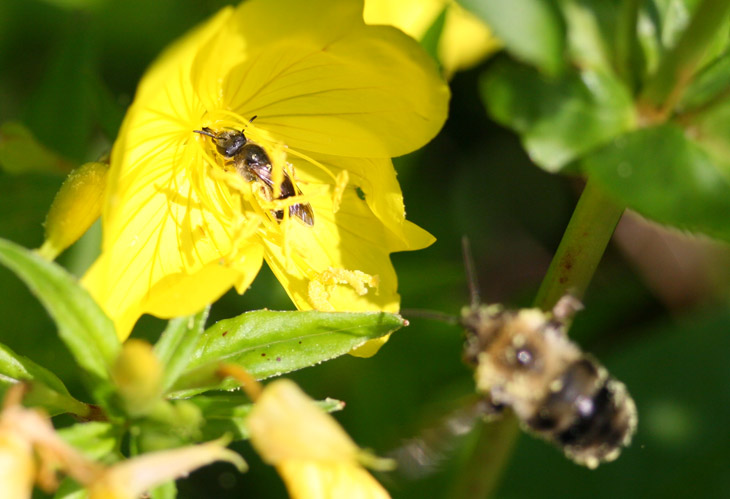
Above, while pinning down focus on a pollinating sweat bee, a bumblebee flew into the frame as the shutter tripped, in a pretty optimal position compositionwise. Too bad the focus was so short.
And before I get to the next image below, a brief bit of background. While out at the nearby pond one night, for some reason without my camera (I’m not sure what I was thinking,) I was seeing plenty of reflections from spider eyes in the headlamp beam – and one especially sparkling one. My suspicions were confirmed as I got closer: it was a mother wolf spider carrying her multitudinous offspring on her back, with their eyes reflecting the light as well. I’ve gotten a few photos of this before, but I’m always aiming for better ones, and she seemed inclined to remain in position, so I noted her location carefully and trotted back home to grab the camera. Unsurprisingly, she had toddled off by the time I got back, but apparently a few of the sprogs had bailed her back and were hanging out in the same location on their own, so I settled for a couple of them instead of a family portrait.

Now, a word of explanation. I had nothing handy to take a measurement, but this little spud was tiny – the leg spread is probably less than the leg spread of a common tick. I could spot them by their reflective eyes (which says a lot, really, if you consider how small those really are,) and had to keep my gaze carefully on that location as I drew closer and the angle got too great to maintain the reflection. It was the only way I would ever have spotted them.
Here’s another one that relied largely on luck.
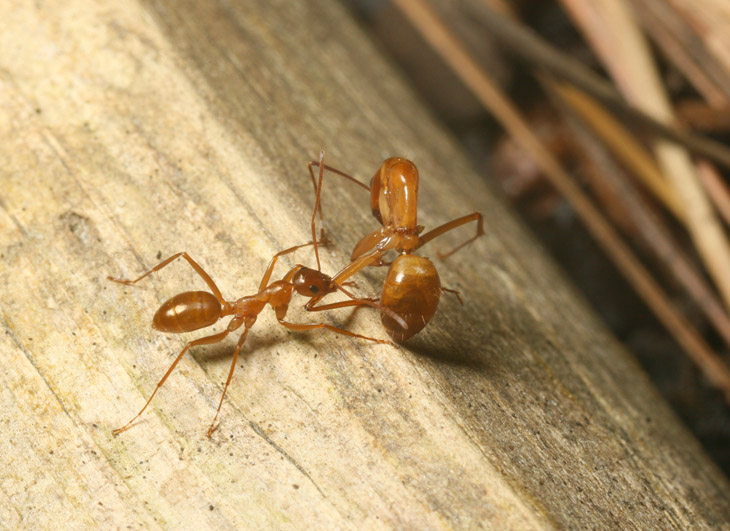
These red ants weren’t very big at all, and the one carrying the corpse of another was moving right along, as ants tend to do. At the magnification I had to use for them, they would flash in and out of focus in less than a second, and tracking them is not as easy as it might seem; they don’t maintain a steady rate nor direction, and once you overshoot and try to backtrack, they take off randomly again. It becomes a matter of very steady movements, anticipation, and timing – plus a lot of luck. There’s a reason I’m balding; I’d probably have a luxurious full head of hair had I not taken up macro photography.
But I still like that image up there, mostly for the “Don’t jump!” impression I get from it.
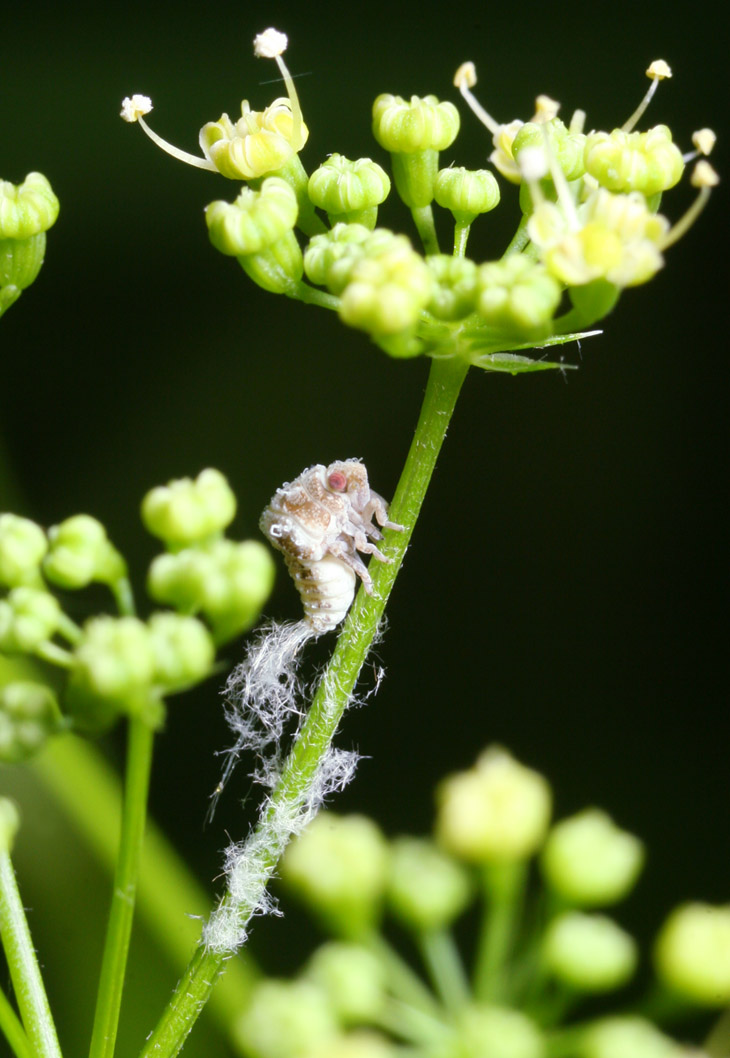
One evening while chasing the mantids, I spotted this leafhopper nymph slurping up fluid from the stem of a parsley blossom. The plumed, fibrous ‘tail’ is pretty much leafhopper poop, and probably serves a protective purpose, even though it seems to attract a lot more attention than the leafhopper itself would have. They go through a lot of fluid, and quite quickly too, so the production of these strands is constant when they’re feeding. Between the foreground blossoms and a cluttered background, as well as things that would have blocked the light from the flash, my choice of angles was very limited, more so than it appears here – I aimed for having a foreground blossom just off the back of the leafhopper and it came out pretty clearly.
You do, of course, remember the massive fishing spider that was hanging out around the pond liner in the backyard? That one eventually disappeared, not being seen again within a night or two of finding it missing a couple of legs, and I think it likely that it fell prey to the resident frogs. But a few weeks ago as I moved some of the plants within the pond, I saw a little spider skate across the surface of the water, and when I located it again and examined it closely, it turns out to be the same species (high likelihood, anyway) as the large one.
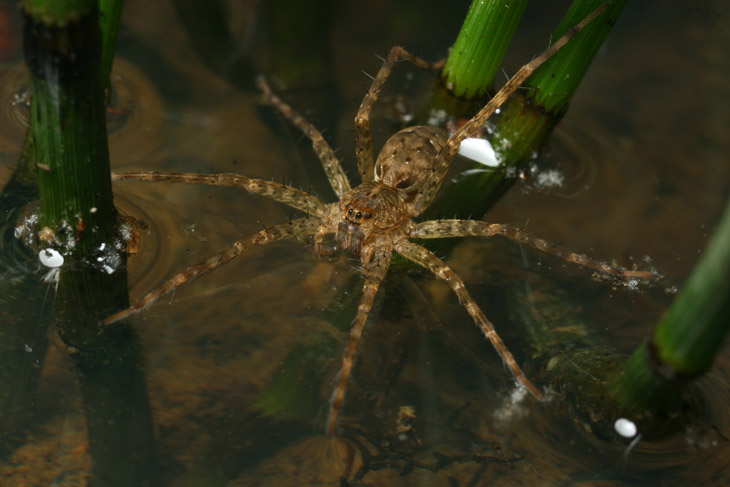
Is this an offspring of the mother, as I speculated upon then? I consider that doubtful myself, since as small as it is, it’s a lot larger than I would have expected, given the time frame – newborns are tiny. I also would have expected the frogs to make quick work of it, but as of tonight it’s still around even though it lives right under their noses.
At the botanical garden the other day, I snagged a newly-emerged adult dragonfly, which leads to a bit of trivia.
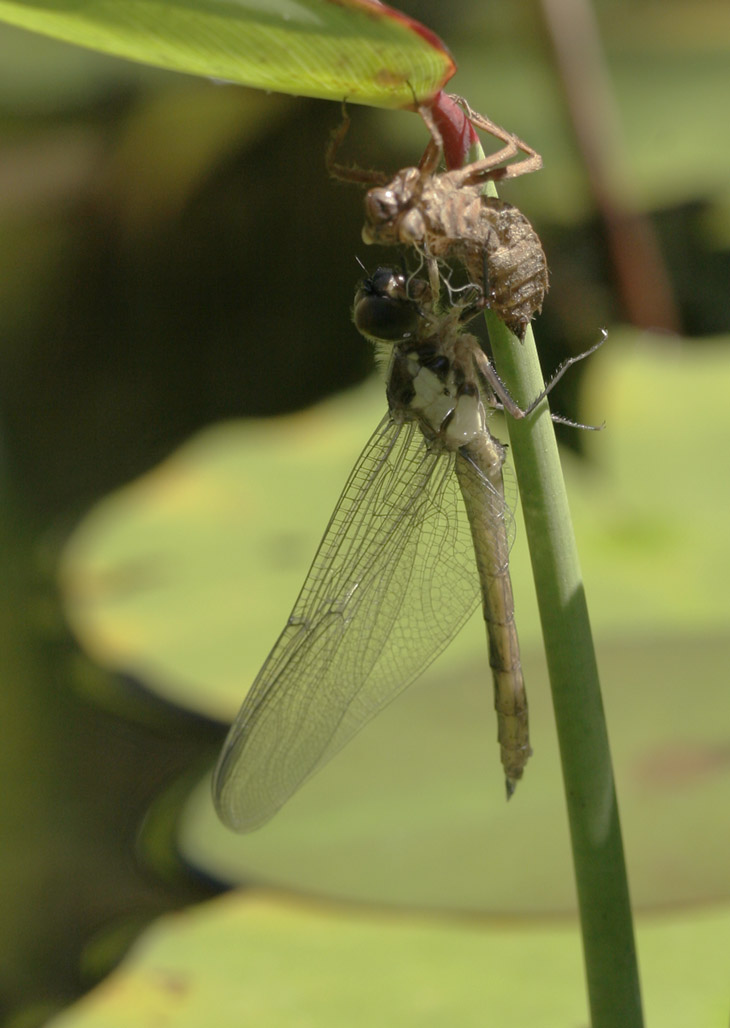
The pale color, and the fact that the wings are sitting upright and not flat out to the sides, indicates that this is a new emergence. The brown insect to the upper right isn’t something else, however – it’s the old exoskeleton that the adult just emerged from. Yes, that big ol’ dragonfly came from that little brown skin, and while you might imagine that the skin shrank considerably after drying out, that’s not the case; the adults really do expand that much as they emerge. I have yet to capture this happening, and now I really have to, because we all have to see it, don’t we?
Here’s a look at one during the nymph stage, which is spent entirely underwater.

Yes, indeed, the eyes are much smaller, the abdomen greatly truncated, and those little flaps on the shoulders will someday become those elaborate dragonfly wings. At this stage in its life, a dragonfly is adapted to an entirely different set of habits and prey – it’s just that the transition between the two isn’t gradual, but takes place in hours.
I mentioned George Hrab’s Geologic podcast before, and I’m going to give you a direct link to one now, because he talks about their peculiar anatomy within – something I didn’t know myself, to be honest. And he does so with his own style, so definitely click here to listen. There’s a lot of other stuff in there too, but it’s hardly a detraction from the specific topic here. Consider it bonus content.
More is coming shortly, or as shortly as I can make it. You know where to find me.



















































